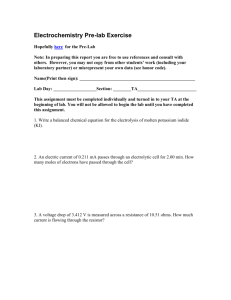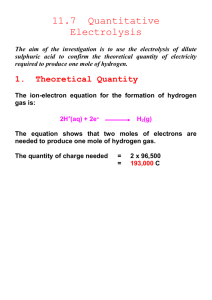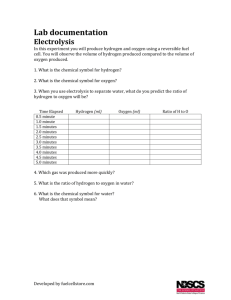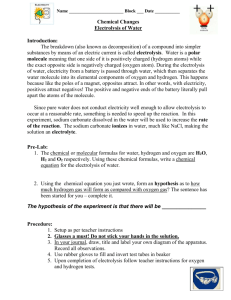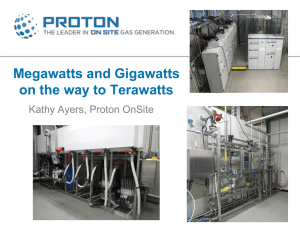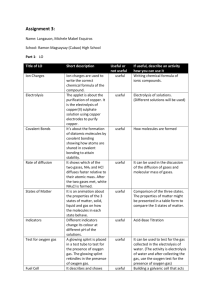Understanding Solar Energy Teacher Page Electrolysis
advertisement
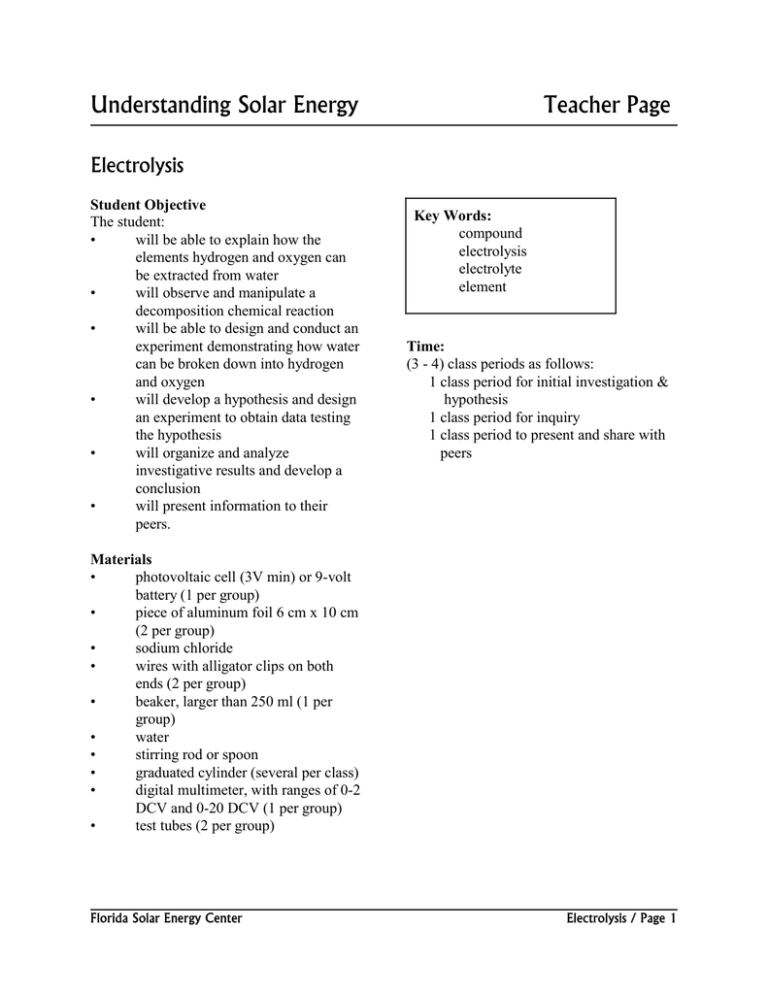
Understanding Solar Energy Teacher Page Electrolysis Student Objective The student: • will be able to explain how the elements hydrogen and oxygen can be extracted from water • will observe and manipulate a decomposition chemical reaction • will be able to design and conduct an experiment demonstrating how water can be broken down into hydrogen and oxygen • will develop a hypothesis and design an experiment to obtain data testing the hypothesis • will organize and analyze investigative results and develop a conclusion • will present information to their peers. Key Words: compound electrolysis electrolyte element Time: (3 - 4) class periods as follows: 1 class period for initial investigation & hypothesis 1 class period for inquiry 1 class period to present and share with peers Materials • photovoltaic cell (3V min) or 9-volt battery (1 per group) • piece of aluminum foil 6 cm x 10 cm (2 per group) • sodium chloride • wires with alligator clips on both ends (2 per group) • beaker, larger than 250 ml (1 per group) • water • stirring rod or spoon • graduated cylinder (several per class) • digital multimeter, with ranges of 0-2 DCV and 0-20 DCV (1 per group) • test tubes (2 per group) Florida Solar Energy Center Electrolysis / Page 1 Background When you add sodium chloride (salt) to water, the salt ions increase the water’s ability to become a good conductor of electricity. Salt also acts as a catalyst increasing the water’s chemical reaction rate. Water is a polar molecule. (If students are not aware of what a polar molecule is then explain: The arrangement or geometry of the atoms is such that one end of the molecule has a positive electrical charge and the other side has a negative charge making it a polar molecule. Water is a polar molecule because the atoms bond covalently in the molecule so excess electrons on the oxygen side (O-) when its valence shell is full can create a lack of electrons producing positive charges on the hydrogen side (H+) side of the molecule. Knowing about polarity should help students understand why each gas (hydrogen and oxygen) moves to a particular electrode. Review and/or show the diagram below: A salt solution forms an electrolyte, allowing current to flow when a voltage is applied. When electricity is applied in the salt solution, bubbles of oxygen gas (O 2) form at the anode, and bubbles of hydrogen gas (H2) form at the cathode. The bubbles are easily seen. Twice as much hydrogen gas is produced as oxygen gas. The process of separating the water molecule into its components, hydrogen and oxygen gases, using an electric current is called electrolysis. This is a ‘redox’ or decomposition type of chemical reaction. At the anode, water is oxidized: 2H2O O2 + 4H+ + 4eAt the cathode, water is reduced: 2H2 + 4OH4H2O + 4eNote that there is a net balance of electrons in the water. Bubbles of oxygen gas (O 2) form at the anode, and bubbles of hydrogen gas (H2) form at the cathode. The bubbles are easily seen. Twice as much hydrogen gas is produced as oxygen gas. The net reaction: 2H2 + O2 2H2O The electricity can be supplied by a solar cell or a battery if sunshine is not available. Once the power source is taken off the electrodes, some gas bubbles remain on the electrodes. Due to these gas bubbles, a voltage difference will be seen when measured. Christian Freidrich Shoenbein carried out this same type of experiment and had his Florida Solar Energy Center Electrolysis / Page 2 results published in 1839. Sir William Robert Grove discovered these gases could be recombined and form energy. He is known as the father of the fuel cell. Procedure 1. Divide the students into lab groups of 3 - 4 students per team. 2. Engage: Students should follow the directions for this lab as stated in their Laboratory Manual for observing an electrolysis reaction. They are to follow the directions, perform the lab, and complete the analysis and application questions in their lab manuals. 3. Assist students as needed during the first investigation making sure they understand the instructions. 4. After the first investigations, student groups need to clean their lab area. 5. Explore: After the first electrolysis investigation, student groups will develop a new testable hypothesis based on their observations. Some guiding testable question examples are listed below, but it will work best if students develop their own question. a. How much gas is being produced? The students should discover they are making 1 part oxygen and 2 parts hydrogen. They could also smell for chlorine, although at the recommended concentrations chlorine may not be detected. b. What gas was collected at each electrode? One method to test the gases is to collect each gas in a separate test tube. Since hydrogen is lighter than air, the test tube should be held upside down when testing with a flaming wood splint. Oxygen’s density is similar to air, so the test tube should be held up and tested with a glowing splint. c. What happens when the concentration of the electrolyte is changed? The rate of the reaction will be different. d. Do other salts work as well as sodium chloride? e. Do other ionic solutions (acids or bases) work as well? Students can safely try weak acids and bases found at home such as vinegar, soda, pickle juice, or baking soda. f. Does the size of the electrodes (surface area) make a difference in the reaction? g. Does the distance apart the electrodes are affect the reaction? h. Does the temperature of the electrolyte make a difference? (Use hot or icy water) Note: Inquiry labs are open-ended exploration activities. Students are responsible for all aspects of the experimental design. Students should be able to explain and justify each step of their procedure. If there is an item in the hypothesis or procedure you don’t like, ask the groups to brainstorm to ‘fix’ or replace what is not acceptable. 6. After student groups have developed their hypothesis, they need to design a procedure, and list the necessary materials to provide an answer to their experimental question. Groups should brainstorm and discuss their procedure before recording their procedural steps. Students can only test one new variable. Insist that the written steps are logical and the procedure includes all safety practices. 7. When the groups procedural steps are completed (and approved by you) student groups will then conduct their investigations. Some student investigations may need additional equipment provided to them or brought from home. 8. When finished, students need to clean their lab area and remove all materials from their Florida Solar Energy Center Electrolysis / Page 3 9. 10. 11. investigations. Students will then develop another new inquiry question they would like to investigate. (These are not performed in this lab, but could be for further research) Explain and Elaborate: After this activity is completed, student groups will present to the class the purpose of their experimental design (their essential question), their hypothesis (what they think will be observed), identify their variables and controls, explain their procedural testing steps, and summarize their results and conclusions. At the conclusion of this presentation students will then identify a new question that emerged from their investigation that they wish they could research. Lead a review discussion covering what students observed and learned in each of their investigations. You may want to prepare formal presentation covering the listed ideas and give points for student participation. Points to cover and ask may include: • Does electrolysis produced a chemical change? Yes. How do you know? What is the evidence? A gas is being produced from the reaction. • Does the Law of Conservation of Energy hold true in this closed system? What evidence confirms your answer? Yes, it is a law which is always true; electric energy is being transformed into chemical energy which also increases the kinetic energy, better known as ‘heat energy’, of the molecules. In a defined closed system as in the electrolysis of water, energy is permeable but not matter. • Is some energy lost when it is transferred to heat? No, all energy must be accounted for when it is transferred, it cannot be destroyed; the Law of Conservation of Energy supports this idea. • Can the process of electrolysis be reversed using a fuel cell–hydrogen and oxygen to combine elements and make electricity and water? Yes • Did you know hydrogen is used as a combustible fuel on the Space Shuttle, can be used to make electricity with a fuel cell, is a renewable resource, and is nonpolluting when used as an energy source? • Why is there a voltage difference after the power is turned off? The molecules continue to react because of their gained potential energy changes. • Did students prefer their inquiry investigation or the initial electrolysis activity best? • What is the difference between an independent and dependent variable? Independent variables are manipulated, measured, and their change is controlled during the test, the dependent variable is the responding result of the independent variable. It is observed and measured, but not controlled by the investigator. • Why was the initial electrolysis investigation necessary? It acted as a control for the inquiry test to compare student’s new hypothesis, to helped identify a new independent variable. • Scientific investigations are performed multiple times so trials confirm and validate results. In the classroom, time and supplies do not always allow for these multiple trials. Did other inquiry groups conduct similar tests and get similar results? • What was learned from the investigations completed by your peers? Florida Solar Energy Center Electrolysis / Page 4 Evaluation and Student Assessment Post the inquiry criteria or discuss them with your students before they begin this project. Suggested Overall Assessment: 50% Lab Manual answers • group or individual grade for questions #1-9, 5 points each • clean lab area and observed group productivity, 5 points 30% inquiry lab and presentation–each part is 1/3 of the grade (see rubric below) • group effort • inquiry design • presentation 20% Problem answers • group or individual grade, 4 points each Criteria Exemplary all skills mastered Intermediate most skills mastered Novice improvement needed Students worked in a safe manner, lab area was kept organized and clean Hypothesis and procedure steps are logical, complete, clear, and connected to the inquiry question. Terms used appropriately. Results and Conclusion are insightful, organized and strategically communicated and connected to the hypothesis. Body Language - eye contact, posture, and body movements Vocals - volume and tone is easy to hear. Voice is enthusiastic. Group members work effectrively and utilize the strength of others; standards and goals deliver an overall, high quality performance. Related Research 1. How does varying the concentration of the salt water affect the number of bubbles or amount of gasses produced by the electric current? 2. How does varying the electrical voltage in hydrolysis circuit affect the amount of gas being produced? Florida Solar Energy Center Electrolysis / Page 5 3. 4. 5. 6. How could you capture and measure the amount of gas produced? Where is hydrogen currently being used in the state of Florida? How much is used per year? Where is it produced? How does the research and production of hydrogen in the state help our economy and our environment? What is a hydrogen fuel cell? How does it work? Related Reading • Hydrogen: Hot Stuff Cool Science–Jouney to a World of Hydrogen Energy and Fuel Cells at the Wasserstoff Farm by Rex Ewing (Pixyjack Press, 2004) This book is a clever, innovative meld of "Harry Potter makes contact with the Hydrogen Wizard and together they travel Back to the Future." At least, those are the images I saw while reading. Science teachers will love "technistoff," the technical notes and references following each chapter. Armed with these, teachers can enrich their own knowledge and understanding of some incredible new technologies of hydrogen generation, storage, and delivery, as well as visiting some very instructive web sites with their students. Internet Sites http://www.bellona.no/en/energy/hydrogen/report_6-2002/22871.html Environmental Foundation Bellona’s report on commercial water electrolysis methods http://fsec.ucf.edu/hydrogen/research/solar_h2_production.htm Florida Solar Energy Center’s research on solar-hydrogen production http://fsec.ucf.edu/hydrogen/research/production.htm Florida Solar Energy Center. Current hydrogen production techniques including relative costs http://northland.cc.mn.us/biology/Biology1111/animations/dissolve.html Northland College. Animation of how ionic compounds dissolve–in this case, salt in water. Florida Solar Energy Center Electrolysis / Page 6 Understanding Solar Energy Answer Key Electrolysis Answers - Laboratory Manual 2 Answers may vary slightly, but should be close to zero. 4 Bubbles because gas is being produced at the electrode. Answers may also mention the breakdown of the aluminum foil 5 Bubbles or gas formed at the electrode in approximately double the amount as the cathode (positive). Answers may also mention the breakdown or corrosion of the aluminum foil. 6 The electrical energy is transformed into chemical energy 7 No energy transformation is ever 100% efficient, heat is a common by product but the Law of Conservation of Energy always holds true. 8 The total amount of bubbles or gas produced would double. 9 Answers may vary, but voltages start at a level close to the voltage of the power supply and fall steadily. 10-15. Each group’s experimental question, hypothesis, materials, procedure, results, and conclusion will vary. Students should show coherent and complete thoughts and a knowledge of experimental design. When their investigations are complete, student groups should plan how to present their data to their peers. All group memebers should have a role in the investigation and presentation. Answers - Problem Set 1. The reactant is water, a clear colorless liquid. The products are hydrogen and oxygen, both of which are odorless, colorless gasses. 2. 2H2O 2H2 + O2 3. It takes energy to separate a compound into its component elements. In this case, as the electric energy passes through the water it separates the water molecules into hydrogen and oxygen molecules. 4. Aluminum electrodes, electrode size, power supply, electrolyte volume or amount, electrolyte concentration, and electrolyte temperature are variable that can be controlled or manipulated that will test the amount (not the ratio) of the gasses (the dependent variable) being produced. The ratio is a fixed amount based on the chemical properties of water. 5. Answers may vary slightly, but students should mention the differences in durability of the aluminum versus platinum. They should have noticed the corrosion or deterioration of the aluminum during their experiemnts. Florida Solar Energy Center Electrolysis / Page 7 Understanding Solar Energy Florida Sunshine Standards Benchmarks Electrolysis 1 2 3 4 5 6 7 8 X X 9 1 0 1 1 1 2 1 3 1 4 1 5 1 6 1 7 1 8 1 9 Nature of Science Standard 1 SC.912.N.1. Standard 3 SC.912.N.3. X X Physical Science Standard 8 SC.912.P.8. X X Standard 10 SC.912.P.10. X X Science Standards Standard 1: The Practice of Science • SC.912.N.1.1- Define a problem based on a specific body of knowledge, for example: biology, chemistry, physics, and earth/space science, and do the following: 1. pose questions about the natural world 2. conduct systematic observations 3. examine books and other sources of information to see what is already known 4. review what is known in light of empirical evidence 5. plan investigations 6. use tools to gather, analyze, and interpret data (this includes the use of measurement in metric and other systems, and also the generation and interpretation of graphical representations of data, including data tables and graphs) 7. pose answers, explanations, or descriptions of events 8. generate explanations that explicate or describe natural phenomena (inferences) 9. use appropriate evidence and reasoning to justify these explanations to others 10. communicate results of scientific investigations, and 11. evaluate the merits of the explanations produced by others. Standard 3: The Role of Theories, Laws, Hypothesis, and Models • SC.912.N.3.3 - Explain that scientific laws are descriptions of specific relationships under given conditions in nature, but do not offer explanations for those relationships. Standard 8: Matter • SC.912.P.8.1 - Differentiate among the four states of matter. • SC.912.P.8.2 - Differentiate between physical and chemical properties and physical and Florida Solar Energy Center Electrolysis / Page 8 2 0 chemical changes in matter • SC.912.P.8.7 - Interpret formula representations of molecules and compounds in terms of composition and structure.. • SC.912.P.8.8 - Characterize types of chemical reactions, for example: redox, acid-basesynthesis, and single and double replacements. Standard 10: Energy • SC.912.P.10.1 - Differentiate among the various forms of energy and recognize that they can be transformed from one form to others. • SC.912.P.10.2 - Explore the Conservation of Energy by differentiating among open, closed, and isolated systems and explain that the total energy in an isolated system is a conserved quantity. Florida Solar Energy Center Electrolysis / Page 9 Understanding Solar Energy Key Words/Definitions Electrolysis compound - composed of two or more substances, ingredients, elements, or parts electrolysis - the chemical process or change produced by breaking molecules into smaller components (called decomposition) using an electrolyte and electric current electrolyte - a substance with free ions (such as acids, bases, or salts) that is capable of conducting an electric current by means of a decomposition chemical change. element - a substance composed of atoms having an identical number of protons in each nucleus; elements cannot be reduced to simpler substances by normal chemical means Florida Solar Energy Center Electrolysis / Page 10 Understanding Solar Energy Laboratory Manual Electrolysis Electrolysis is a technique used by scientists to separate a compound or molecule into its component parts. By adding electricity to a conducting liquid while providing a path for the ions to follow, a liquid such as water can be separated into hydrogen and oxygen. Safety • Safety goggles and apron must be worn throughout this activity. Students must stay on task when working with electricity and water. Procedure In this experiment you will be following an electrolysis procedure by using a sample of salt water, adding an electric current to it, and observing the decomposition of its components. You will see the hydrogen and oxygen bubbling up. 1. 2. 3. 4. Set up your electrolysis apparatus • Accordion-fold each piece of aluminum foil lengthwise so you have two pieces approximately 1 cm x 6 cm. These folded aluminum sheets are your electrodes. • Press each electrode flat. • Bend the top 1 cm of each electrode over to act as a hanger. Hang them on the inside of your bowl. • Attach one end of each wire to each hanger top of your electrode. • To mix your electrolyte, add sodium chloride (salt) to water using a concentration of one teaspoon of salt per 50 mL of water. Stir until dissolved and add this electrolyte to your bowl. • The electrodes (on the inside of the bowl) should hang down into the water and be 2 - 3 inches apart; do not let them touch during the experiment. Adjust the electrodes as necessary. You may add more salt water if necessary, maintaining the concentration of 1 teaspoon per 50 ml of water. Using the multimeter probes, touch one to each electrode. Measure and record the initial voltage reading (before you connect the power supply) in the data table below. Hook your electrolysis apparatus to the power supply: • Attach one end of each wire to an electrode and the other end to either a photovoltaic panel or battery. Make a note which electrode is attached to the positive terminal (or photovoltaic connection) and which is attached to the negative. • If using photovoltaics, take your electrolysis device outside into the sun. Record the voltage reading across the multimeter every 10 seconds for one minute as you and your group members observe this electrolysis reaction and answer questions 5 - 10. After one minute, disconnect the power source and take one final voltage reading. Florida Solar Energy Center Electrolysis / Page 11 Caution: Do not allow other items to touch the electrodes or drop into the electrolyte solution, including your fingers and hands. Record all data in the table below: Elapsed Time Voltage Initial voltage (before connecting power supply) 10 seconds 20 seconds 30 seconds 40 seconds 50 seconds 60 seconds Voltage immediately after disconnecting power supply Answer the following questions 5. What did you see happening at the positive electrode? 6. What did you see happening at the negative electrode? 7. Since energy cannot be created or destroyed, what happened to the electrical energy? 8. If you left this apparatus working long enough, it would heat up the water. Why? 9. If you doubled the electric current flowing through the water, what would you expect to happen? Florida Solar Energy Center Electrolysis / Page 12 Cleanup and Disposal • Follow your teacher’s instructions regarding cleanup of your station and disposal of any chemicals. • Wash your hands thoroughly with soap and water after all your work is finished. Independent Group Inquiry Investigation Record your group’s inquiry investigation plan. Your hyporthesis and procedure must be approved by your teacher before your actual test. 11. Purpose of the Inquiry: (What question will this investigation answer) 12. Hypothesis: (What results are you expecting?) 13. Procedure: Teacher approval check: __________ What did you keep controlled during this investigation? (What did not change from your original electrolysis investigation?) What is your independent variable? (What did you decide to manipulate and change for this new test?) What is your dependent variable? (What will you observe and measure because of the independent variable being different from the original investigation?) Florida Solar Energy Center Electrolysis / Page 13 14. Materials needed: 15. Collect the materials necessary, and conduct your experiment. Record your observations below in a scientific and orderly manner. 16. Did your results support your hypothesis? Explain why or why not. What conclusions can be made from this investigation? Florida Solar Energy Center Electrolysis / Page 14 17. What further questions emerged during this experiment? Note to students: Due to a lack of funding (additional grant money was denied) and time (current project has ended) this inquiry cannot be completed. Investigators will need to find new sponsors and submit a grant proposal! Cleanup and Disposal • Follow your teacher’s instructions regarding cleanup of your station and disposal of any chemicals. • Wash your hands thoroughly with soap and water after all your work is finished. Presentation 18. Organize and plan to present your inquiry investigation fo the class. All group members should have a role and be present for this part of the investigative activity. Your presentation to your peers should include the following information: • Inquiry purpose or essential question • Hypothesis • Procedure and materials • Results – data collected • Conclusion – restate the purpose of the investigation, where the objective achieved, and was the hypothesis proven or disproved • Future works plan - new inquiry your group wishes to investigate Note: Keep this investigative information for a future project in Fuel Cells - Futuristic Battery Florida Solar Energy Center Electrolysis / Page 15 Understanding Solar Energy Problems Electrolysis 1. Name and describe the reactant and products in the electrolysis experiment. 2. Write a balanced equation for the reaction that took place. 3. Why does this reaction happen? 4. Fuel cells use platinum for the electrodes. We used aluminum in this lab. Why don’t fuel cells use aluminum? Florida Solar Energy Center Electrolysis / Page 16
